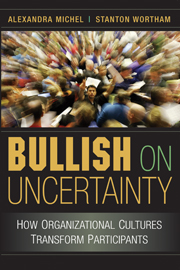1 - Bullish on Uncertainty
Published online by Cambridge University Press: 10 January 2011
Summary
Our research uncovered a puzzle. Two highly successful investment banks were experiencing high uncertainty because globalization and industry deregulation demanded a new way of doing business. The two investment banks advised top executives of Fortune 100 companies about raising capital, taking companies public or private, and restructuring businesses. These tasks were becoming more complicated in the 1990s, however, because the environments around investment banking were changing rapidly. To assist bankers in making effective decisions amidst this turbulence, the banks designed work practices that managed uncertainty. But the two banks, “Individual Bank” and “Organization Bank,” managed uncertainty in divergent ways. Individual Bank used familiar practices to reduce uncertainty for employees – explicit strategies and organizational structures, clear role definitions, careful feedback to bankers, and extensive training. Organization Bank, in contrast, used puzzling practices that amplified uncertainty, highlighting and even intentionally creating additional uncertainty for bankers. It deemphasized explicit strategies and roles, feedback was difficult to interpret, and training was full of contradiction and viewed as relatively unimportant.
THE TWO BANKS' APPROACHES
Individual Bank's approach followed traditional organizational theory. From this perspective, uncertainty is pervasive in business and, because it can impede decision making, its reduction should be a central priority for management (March and Simon,1958; Simon, 1976). The management literature describes this priority clearly. Uncertainty reduction is viewed as a “fundamental need” for individual employees (Hogg and Mullin, 1999: 253; Hogg and Terry, 2000), who experience uncertainty as frustrating, disorienting, and aversive (Katz, 1985; Schein, 1978).
- Type
- Chapter
- Information
- Bullish on UncertaintyHow Organizational Cultures Transform Participants, pp. 1 - 34Publisher: Cambridge University PressPrint publication year: 2008



